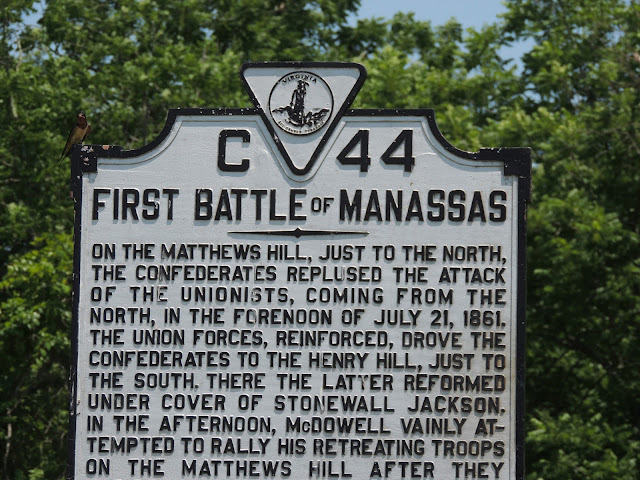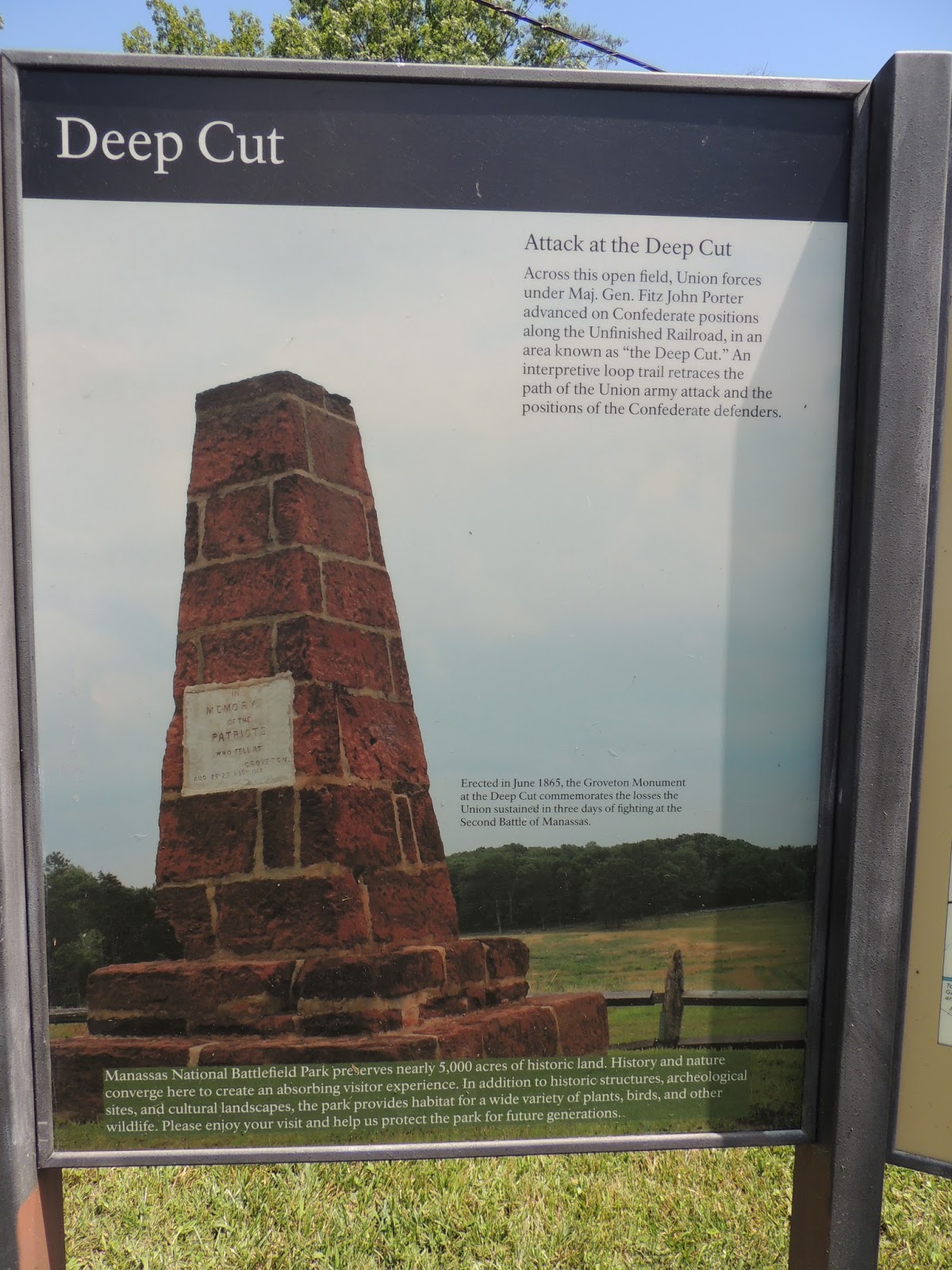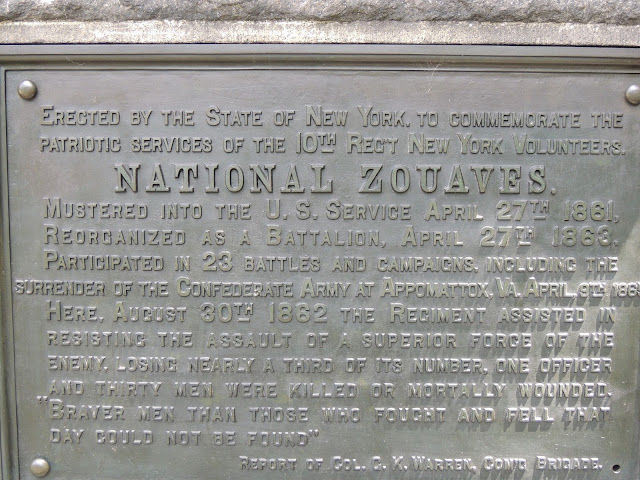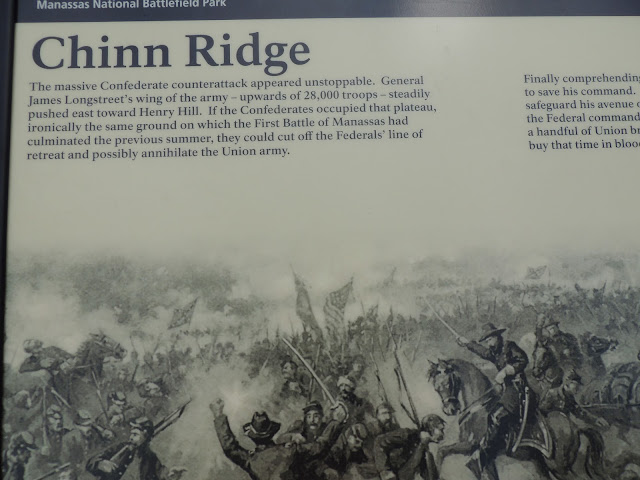Manassas, VA
Manassas National Battlefield Park
To learn more about the first and second battles of Manassas (Bull Run) check out the National Park site:
https://www.nps.gov/mana/index.htm
Battle of First Manassas July, 1861
We began our tour at Henry Hill and the Battle of First Manassas. The Union called it the Battle of Bull Run.
Both sides were so confident that victory would be theirs, and end the war in one battle, that families gathered on the hillsides with picnic baskets to watch their side win the war.
At the end of the day, 900 men and boys were killed, as well as an 84 year old civilian woman, and the picnic was over.
The Blue Ridge Mountains in the distance
This is called a Limber and was pulled by horses. The cannon was attached to the back, the box carried the munitions.
The first battle of Manassas is said to be the very first battle of the Civil War.
Judith Henry's home site. This is not the original house.
The Henry Family Burial plot. Judith Henry was mortally wounded when Union soldiers fired cannons into the house, because they thought there were confederates inside. Instead, this 84 year woman was the first civilian casualty of the Civil War.
Inside the Henry house was an exhibit.
A memorial was erected to honor the fallen.
Bull Run Monument
Brigadier General Francis Stebbings Bartow was the first Confederate Officer to be killed in the Civil War
The fields around Henry Hill
The Henry farmhouse
A butterfly on a log.
General Barnard-Elliott Bee is said to have given his troops the command form behind Jackson who stands like a stonewall, thus giving the nickname to "Stonewall" Jackson.
Second Battle of Manassas August 28, 1862
Brawner Farm. The Brawner's were tenant farmers here, their home sustained major damage in this battle and they abandon the farm after the battle.
Stonewall Jackson and his troops hid just north of this farm, at Stony Ridge. Union troops were marching East and the Confederate army opened fire, the Union troops became trapped between the artillery and Jackson's army. This battle continued for two hours and ended when the union troops managed to retreat. About a third of the 7000 men present were killed.
The uniforms of the 5th New York proved a liability for the troops. They were easy to spot from a great distance.
/ZHo͞oˈäv/
noun
- 1.a member of a light-infantry corps in the French army, originally formed of Algerians and long retaining their oriental uniform.
- 2.women's trousers with wide tops, tapering to a narrow ankle.
Powered by Oxford Dictionaries
The Emancipation Proclamation was written in the summer of 1862, but Lincoln decided to wait to announce it until the Union secured victory. He made the announcement in January 1863.
For more info:
http://www.history.com/topics/american-civil-war/emancipation-proclamation
Both the Union and Confederate armies occupied this hilltop during the battle.
A storm came through this area the night before, these tree show the aftermath of the storm.
The Stone House. A tavern turned shelter and hospital for wounded Union soldiers.
These signs were by the parking lot for the Stone House.
Matthews Hill. The inexperience of the soldiers really showed here as the troops marched, many lagged behind to pick berries and eat them, which spread out the forces, and allowed the Confederate army to stand.
Sudley. The federal troops repeatedly attacked Jackson's army and just might have won this battle if there was more daylight.
The Unfinished Railroad bed provided Jackson with the cover he needed.
Deep Cut Mistakenly believing that the Confederates were retreating, Pope ordered an assault and became aware that he made a dire mistake.
Groveton Confederate Cemetery. As many as 500 soldiers are buried here in trench graves.
This small house is all that is left of the town of Groveton.
A peek inside the house.
The New York Monuments. The New York 5th and 10th regiments stood there ground and, in five minutes, 123 soldiers were slaughtered. This was the greatest loss of life from a single infantry regiment.
Chinn Ridge Along this ridge the federalists fought desperately to hold off Longstreet's army.
Colonel Fletcher Webster, the eldest son of Senator Daniel Webster was killed leading the 12th Massachusetts Infantry.
The Home of Benjamin Chinn.
What is left of Hazel Plain
Got this from You Tube, thought it was interesting.
https://youtu.be/d3UiKiVf7Tk
Published on Jul 4, 2014
While visiting Manassas National Battlefield Park in Virginia I found this cemetery. The Hooe Family Cemetery contains the tomb stone of Captain Bernard Hooe, Senior. Captain Bernard Hooe was a Captain of Militia in Prince William Co., VA, Oct 17, 1776. On April 7, 1780, Bernard Hooe was deeded part of the "Buckhall" land by his parents, John and Anne. He died on April 8, 1810, as a result of a duel. He was prominent in local political affairs and represented Prince William County, Virginia in the state legislature. He had a political quarrel with a neighbor, James Kemp, in which he struck Kemp with a whip. The subsequent duel took place on the Maryland shore, across the Potomac River. He was mortally wounded and died at "Rippon Lodge", the home of Col. Thomas Blackburn. ("Descendants of Rice Hooe").
We also met a man at the Chinn house ruins and he said many of the tombstones were buried over the years and only the top could be seen, here's one.
 We
We
Portici The plantation of Francis Lewis and served as Confederate headquarters during the 1st Manassas, and a battleground during the 2nd. The house was destroyed by fire in 1862.
The Stone Bridge
The Greenville Family Farm, our Campground at Haymarket, VA
June 21, 2017
Ben Lomond Historic Site
Ben Lomond and its outbuildings were constructed for Benjamin Tasker Chinn in 1832. Confederate forces used Ben Lomond as a hospital following the 1861 Battle of First Manassas. Signatures of Federal soldiers who occupied the property in 1862 are still visible inside the house.
The Rose Garden
The Smokehouse
This would have been the Kitchen
The Main House
The Slave Quarters
Another view of the Rose Garden.










































































































































































No comments:
Post a Comment